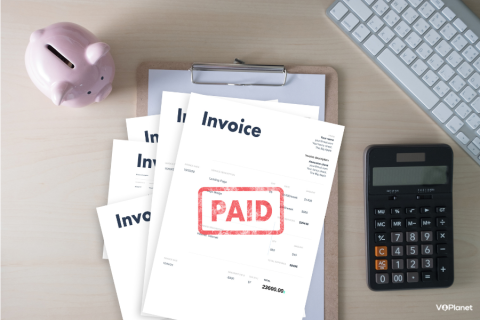
What To Include in Your Voice Over Invoice
After you’ve completed your voice over job, it’s time to send the bill so you can get paid. But what exactly should you include on your invoice? Creating a clear and professional voice over invoice is essential for ensuring timely payment and maintaining a positive client relationship.
An invoice serves as a formal request for payment and outlines the terms of your services and sets expectations for both you and your client. Understanding what to include can streamline your billing process and help you get paid more easily. Let's explore the key elements that should be included on every invoice to help you effectively manage your invoicing and ensure you get paid promptly for your voice over work.
1. Invoice Number
Your invoice should include a clear invoice number. It is a unique identifier for each transaction, allowing you to track and manage your invoices efficiently. When creating invoices, assigning a sequential invoice number helps organize your financial records and provides a reference point for future inquiries or audits.
The invoice number is essential for your client's accounting processes, as they will use this number when remitting payment. This ensures clarity and accountability in the payment process, facilitating easily trackable transactions between you and your clients.
2. Your Name or Business Name
Your name or business name is a fundamental element of your voice over invoice and is typically positioned in the top left-hand corner. Including this information establishes your identity as the service provider, tells the client who to make the payment to, and lets your client know who to contact regarding payment or any inquiries related to the invoice. For freelance voice actors, using your name or registered business name enhances professionalism and builds trust. This clear identification also simplifies accounting and tax reporting on both ends, contributing to a transparent and organized billing process.
3. Voice Over Job Description
Including a job description on your invoice provides essential details about the services rendered. This description typically outlines the details of the voice over work performed, such as narration for a corporate video or recording for a radio commercial. Specifying the job description documents the scope of work completed and the corresponding charges. If you record multiple scripts for a client, including the script title or identifying job or purchase order (PO) number is helpful. It also serves as a reference point for future communications and helps resolve any discrepancies that may arise during the billing process.
4. Your Voice Over Rate
You should clearly state your rate on your voice over invoice. Your rate should reflect the agreed-upon compensation for your voice over services and should be clearly documented to avoid any misunderstandings. Whether you charge per hour, per project, or per word, detailing your rate in the invoice provides clarity on how the total amount due is calculated.
If you charge a studio fee or a fee for a directed session, those expenses should be listed on your invoice. This information helps you and your client understand the financial terms of the agreement and facilitates prompt and accurate payment processing.

5. Total Amount Due
You should always include the total amount due on your invoice. This figure represents the total amount of all charges, including fees based on your rate and any additional expenses incurred during the project. By providing a clear breakdown of costs and the total amount due, you facilitate efficient invoicing and contribute to a smooth transaction process between you and your client.
6. Your Preferred Method of Payment
Indicating your preferred method of payment on your voice over invoice helps facilitate timely transactions. Whether you prefer payment via PayPal, bank transfer, or another method, clearly stating this information helps streamline the payment process for your client.
If PayPal is your preferred method, include your PayPal address on the invoice to ensure accurate funds transfer. Providing these details upfront ensures clarity and minimizes delays in payment processing.
7. Your Payment Terms
The payment terms you agreed to when negotiating the voice over job should be outlined on your invoice. Payment terms outline the timeframe within which payment is expected to be made after the invoice date. Common payment terms include “due upon receipt” and "Net 30 days," indicating that payment is due within 30 days of the invoice date, or specific dates for milestone payments if applicable. Clearly stating your payment terms helps avoid misunderstandings and encourages timely remittance. It also provides a basis for addressing any payment delays or disputes that may arise.
Be Aware of File Sizes
When preparing your voice over invoice, avoid including large photos such as headshots or large logos that may unnecessarily increase the file size or distract from the essential billing information. While a small, professional logo is acceptable and can enhance branding, large images can make the invoice cumbersome to download, view, or print. Keeping the invoice focused on clear and concise billing details ensures that your client can easily review and process the payment without unnecessary distractions.
Invoicing Security Tip
You should never include your social security number on your invoice. You may submit this information on a W9 for tax purposes, but you should not include your social security number on invoices.
Creating a clear and comprehensive voice over invoice is key to professional invoicing practices. A well-crafted invoice enhances professionalism and establishes clear expectations, contributing to a positive client experience and timely payment for your voice over services.
VOPlanet is a global voice over marketplace that connects professional freelance voice actors with creators, casting directors and other voice buyers. Want to join our voice over team? Learn more about how to find voice over work.
You may also enjoy: Voice Over Demo Dos and Don'ts




 VOPlanet Blog
VOPlanet Blog